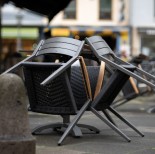Interior shots of the SpaceX Crew Dragon spacecraft were revealed earlier this week. From the looks of it, astronauts will be heading off into space in style and comfort.
"The gumdrop-shaped capsule measures about 20 feet tall by 12 feet in diameter, which is not a lot of space, considering it's designed to carry up to 7 astronauts at a time," Popular Science said.
Still, SpaceX's manned spacecraft is still bigger than its Russian counterpart, the three-passenger Soyuz, as noted by the website.
The Crew Dragon's design is still being finalized. But in its current iteration, Wired said, "the interior looks something like a futuristic sports car." The UK website took note of its "minimalist white and black design."
But being a spacecraft, the SpaceX Crew Dragon doesn't just look pretty. It's also packed with high-tech doodads you'd expect from such a vehicle.
Citing SpaceX, Mashable said, "the astronauts aboard the Crew Dragon will be able to set the interior temperature to between 65 and 80 degrees Fahrenheit, using the built-in Environment Control and Life Support System (ECLSS).
In case of emergency, the crew can eject to safety via an advanced emergency escape system tested earlier this year. The Crew Dragon can be controlled both by astronauts on board or by SpaceX's planetside mission control.
The spacecraft's interior won't be a jarring ride as the Hawthorne, Calif.-based company said it "was designed to be an enjoyable ride."
"With four windows, passengers can take in views of Earth, the Moon and the wider Solar System right from their seats, which are made from the highest-grade carbon fiber and Alcantara cloth."
The SpaceX Crew Dragon, along with Boeings CST-100 Starliner, are part of NASA's Commercial Crew Program which has both companies flying missions to the International Space Station and lessen the space agency's dependence on the Russian Soyuz.
If all goes well, both spacecraft will begin manned spaceflights to the ISS by 2017.



















